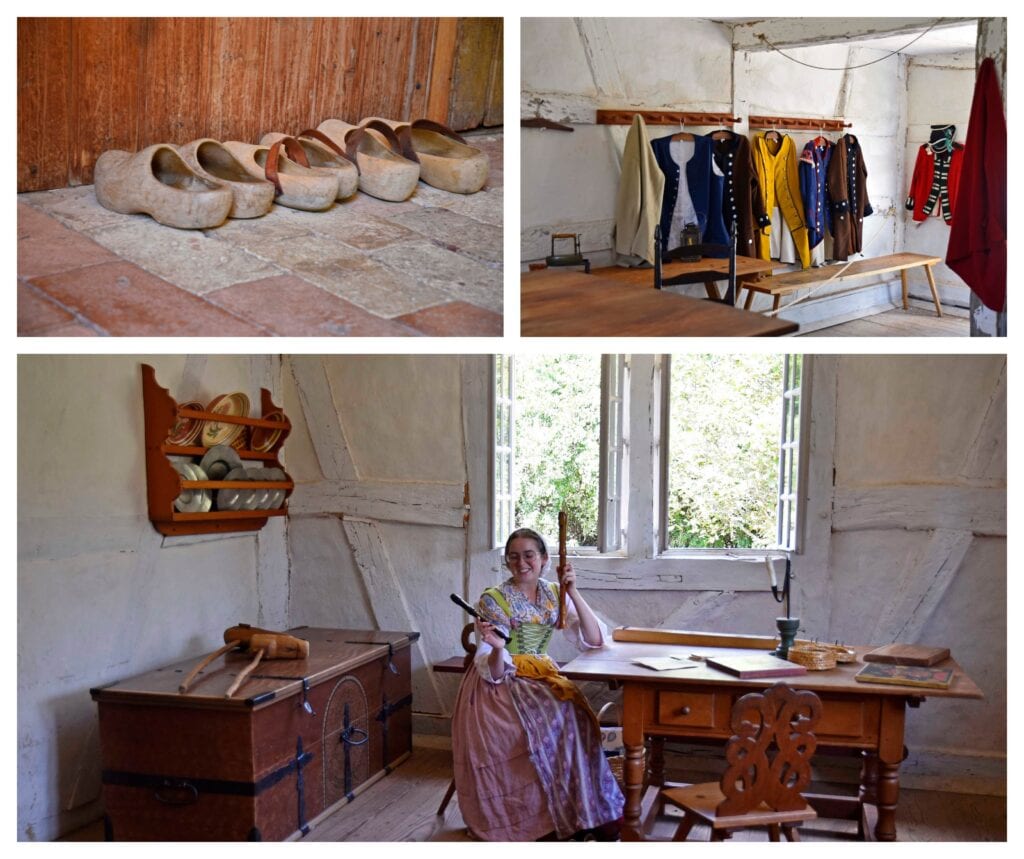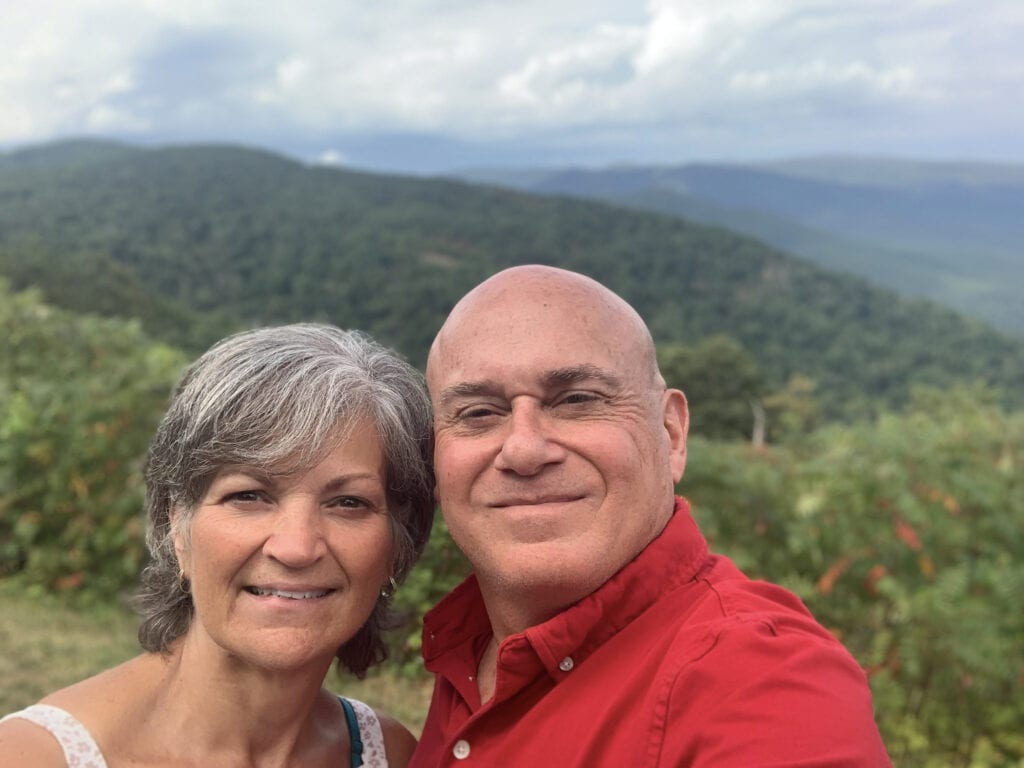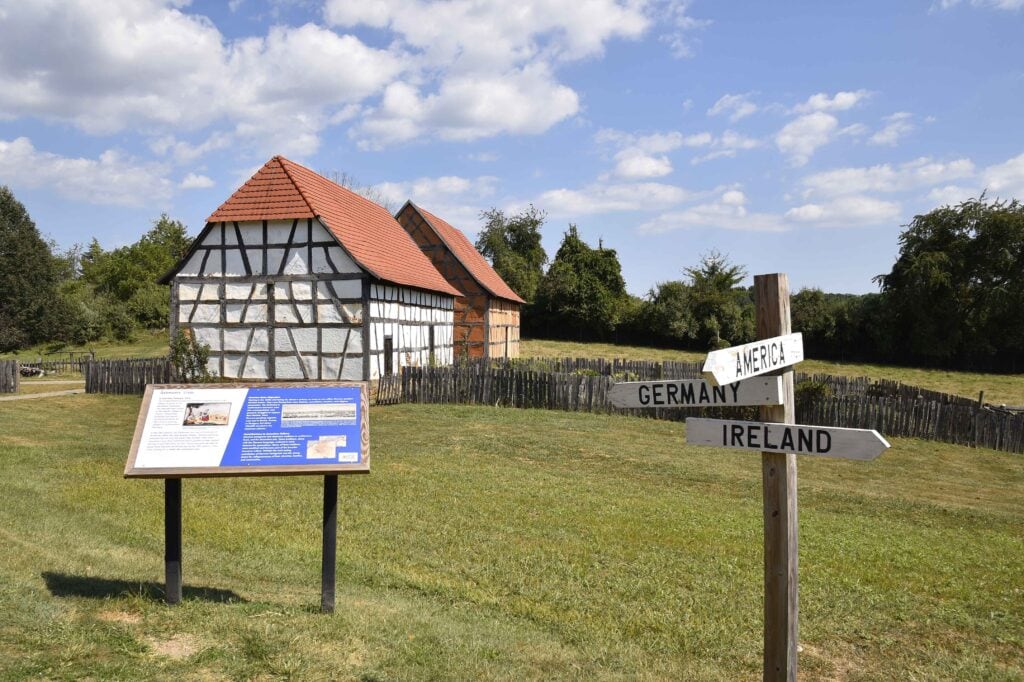Traveling to Virginia gave us our first views of the Shenandoah Valley. As pioneers poured into the region, during the 1600s and 1700s, many passed through this area. With an agricultural-based economy, farming was key to almost every family. Our first Virginia stop landed us at the Frontier Culture Museum, in Staunton. We were eager to interact with the costumed interpreters who tell stories about the past.

West Africa
The first exhibit was just a short drive down the path. We parked near the turnoff for West Africa and walked a short distance to the display. The structure is a reproduction from 18th-century Igboland, now part of Nigeria. The West African people of that region focused on agriculture and trade. By the start of the 1700s, the slave trade was already well established. Estimates are that about 30,000 Igbo slaves were shipped to Virginia during the first half of the century. From the 1400s to the late 1800s, more than 10 million Africans were sold into slavery.

Germany
Moving through the museum grounds, we soon found ourselves in 1750s Germany. This Frontier Culture Museum exhibit included a wood-framed home and barn, which was originally located in Rhineland. By the time of the Revolutionary War, hard times in their homeland had forced about 100,000 Germans to migrate to the colonies. This was only about one-tenth of the total number who left Germany during the Great Auswanderung (emigration). After a dozen weeks on a crowded ship, they were eager to see dry land.

A Look Inside
We stepped inside the house to listen to the interpreter. She was in the middle of describing some of the leisure activities of the farmers. The Germans were adept at pottery, lavishly decorated furniture, and long-rifle construction. We were surprised to learn that these early inhabitants often wore wooden shoes, like the Dutch. (We found a lot of those during a visit to Pella, Iowa.)

England
Back to our cart and up the road to 1650s England. Here we found another timber-frame structure. This particular building came from Worcestershire, England. The Dark Ages ended in England by the start of the 16th century. As the lands became enclosed, many citizens chose to flee across the ocean to the New World. We’d learn more about this when we make it to Williamsburg and Jamesport, later in this trip.

Life Lessons
We joined a small group that had assembled inside the house. The interpreter was in the middle of detailing life in the Shenandoah Valley during the earliest days of English immigrants. The modest bedroom would have had to handle a small crowd, as these early homes had limited space. Behind the home was a small garden, which represented the types of plants that would have been grown during that time period.

Ireland
As we pulled up to the Irish exhibit, we were discussing how much work must have been involved in relocating so many structures. Here we were facing a complete farm and forge. Most Irish immigrants came from Ulster to the Pennsylvania region in the early 1700s. With plenty of competition for space, many moved south toward the Appalachians. Most of these Protestant families were tenant farmers who leased land from wealthy English landlords.

Farming Life
After exploring the barn and grounds, we headed inside the house. Two interpreters were engaged in daily chores. We listened as one described how weaving was used to supplement the farms. With selling linens being their major sustenance, most of the food crops were strictly for family use. By the Revolutionary War, more than 100,000 Ulster immigrants had arrived in America. They often settled in the lands that served as a buffer between the native Tribes and the older English settlements.

Native Tribe
We wrapped up the European farms and made our way to the American exhibits. All of these are focused on the Great Appalachian Valley beginning in the 1600s. The first we came to was the Eastern Woodlands Indian display. When Europeans first arrived, there were dozens of native tribes along the Eastern seaboard. American tribes were helpful to the ill-equipped immigrants. As English colonization expanded, it spelled disaster for the lifestyle of the natives.

Virginia 1760
By the late 1720s, settlers had made their way into the Appalachian river valleys. We came upon this one-room log cabin that represents the typical home of early settlers. They quickly learned farming and hunting techniques from the natives. Corn was a mainstay of their diet but hemp would become a cash crop grown for its fiber. Clearing the land for crops was exhausting work, as noted by the two interpreters we found resting in the shade.

A Virginia Homestead
By the 1850s, homesteads were well-established across Virginia. The version represented at the Frontier Culture Museum would have been owned by “everyday folk”. A road system was being developed, which allowed farming families easier access to markets. The individual ethnic distinctions were declining as intermarriage blended the lines. By this period in history, America had already expanded westward. The Louisiana Purchase more than doubled the size of the young nation. Many Virginians poured into these lands to establish new communities and seek wealth.

Frontier Culture Museum Details
The Frontier Culture Museum operates seven days a week, except for major holidays. At the time of our visit, in 2023, tickets were $12 per person. We tossed in a golf cart rental for around $5 for our visit. Many visitors managed on foot, but we were on a limited timeframe, so the cart came in handy. The museum is well-designed and took us about 1 1/2 hours to see. We could see extending this to about 2 1/2 hours for a more in-depth visit.





